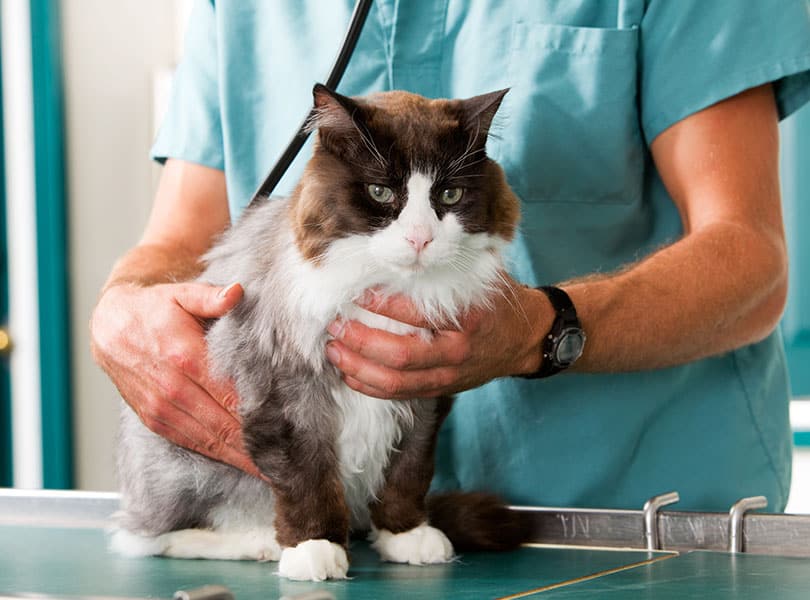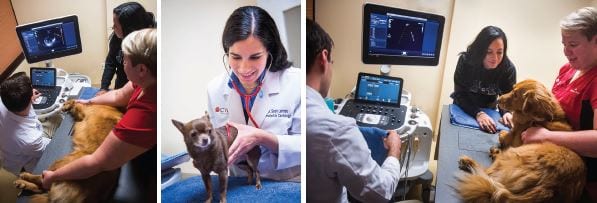A Beginner’s Guide to Understanding CT Scans For Dogs}
Wiki Article
The Role of Ultrasound and CT Scan in Modern Vet Practices: Insights From Experienced Professionals
In modern vet practices, ultrasound and CT scans greatly boost diagnostic capacities. These imaging strategies give vital understandings right into animal health and wellness, assisting therapy choices. Experienced experts identify the distinct benefits of each technique. Ultrasound supplies real-time assessments, while CT checks provide intricate physiological details. Recognizing their applications and duties raises vital questions about their influence on patient outcomes and the future of vet diagnostics. What insights can be gotten from their incorporated use?Recognizing Ultrasound in Vet Medicine
Ultrasound is an essential analysis device in vet medicine, providing a non-invasive method to imagine inner structures. This imaging method uses high-frequency audio waves to create real-time images of organs and tissues, enabling vets to evaluate conditions without surgical treatment. Usual applications include evaluating the heart, liver, kidneys, and reproductive organs, in addition to checking pregnancies.The treatment is reasonably quick and can be done in numerous settings, making it an obtainable choice for vets. Unlike radiography, ultrasound supplies comprehensive information about soft tissues and blood flow, which is vital for precise diagnoses.Veterinary experts rely upon ultrasound to spot abnormalities such as lumps, cysts, and fluid build-up. Its capacity to assist biopsies and other procedures even more boosts its energy in clinical practice. By providing a efficient and safe method to take a look at inner makeup, ultrasound has actually become a keystone of modern veterinary diagnostics.
The Advantages of CT Checks for Pet Diagnostics
CT checks offer considerable benefits in veterinary diagnostics by giving boosted precision in determining inner problems (Ultrasound For Dogs). As a non-invasive imaging technique, they ensure the safety and comfort of pets throughout exams. On top of that, CT checks assist in an extensive evaluation of internal structures, permitting for much more reliable therapy preparationImproved Diagnostic Precision
Improvements in imaging modern technology have actually considerably improved diagnostic accuracy in vet medicine, specifically via making use of CT scans. These scans provide thorough cross-sectional pictures of a pet's internal structures, permitting veterinarians to determine irregularities with precision. The high resolution and three-dimensional capabilities of CT imaging assist in the discovery of problems such as lumps, fractures, and inner blood loss that could be missed out on with conventional imaging methods. Additionally, CT scans can aid in pre-surgical preparation by providing a thorough view of physiological relationships. This degree of detail not just boosts the accuracy of diagnoses but also aids in customizing reliable therapy strategies. The integration of CT modern technology into veterinary practices is changing the landscape of animal health care, improving results for clients.Non-Invasive Imaging Method
The intro of non-invasive imaging strategies has actually revolutionized animal diagnostics, with CT scans becoming a noticeable device in veterinary practices. These scans offer high-resolution, cross-sectional photos of a pet's internal structures, permitting veterinarians to analyze intricate problems without the need for intrusive treatments. The advantages of CT scans include their capability to identify lumps, cracks, and internal bleeding with impressive precision. Furthermore, they help with the evaluation of soft tissues and body organs, improving diagnostic capacities. The speed of CT scanning makes it possible for quick decision-making, which is important in emergency situation scenarios. By decreasing tension and pain for the animal, CT scans add to a much more gentle technique to diagnostics, ultimately boosting treatment outcomes and advancing veterinary treatment.Comprehensive Internal Assessment
A comprehensive internal assessment is important for precise diagnosis and efficient therapy in vet medicine. CT checks offer substantial advantages hereof, giving comprehensive cross-sectional photos of a pet's internal structures. This advanced imaging method boosts visualization of complex physiological regions, allowing veterinarians to identify problems such as growths, cracks, and interior blood loss with higher accuracy. In addition, CT checks assist in the assessment of problems that may be challenging to diagnose via traditional methods. The rate and accuracy of CT imaging also add to prompt treatments, enhancing client end results. As vet methods progressively integrate CT modern technology, the advantages of considerable inner evaluations become apparent, reinforcing the significance of this device in contemporary vet diagnostics.Contrasting Ultrasound and CT Imaging Techniques
While both ultrasound and CT imaging serve essential duties in vet diagnostics, each technique uses unique advantages and limitations that can affect medical decision-making. Ultrasound is particularly valued for its real-time imaging capabilities, enabling veterinarians to observe vibrant physical procedures. This method is non-invasive, portable, and does not include ionizing radiation, making it a much safer alternative for both medical professionals and animals. Nonetheless, ultrasound may have limitations in picturing particular anatomical structures or deep tissues.Conversely, CT imaging gives in-depth cross-sectional views of the body, permitting for exact localization of problems. It masters reviewing complicated organs and frameworks, particularly in the thorax and abdominal area. Nonetheless, CT scans require sedation or anesthesia in several instances and include direct exposure to ionizing radiation. Inevitably, the option in between ultrasound and CT depends on the certain professional scenario, the area of rate of interest, and the seriousness of the diagnostic needs.Situation Studies: Effective Medical Diagnoses Through Imaging
Study highlight the significant renovations in analysis accuracy attained with innovative imaging modern technologies like ultrasound and CT scans in veterinary methods. These advancements not just improve the discovery of different conditions however also assist in prompt and effective therapy strategies. Examining specific situations can highlight the transformative influence of these imaging techniques on vet medication.Diagnostic Accuracy Improvements

Imaging Modern Technology Advancements
As vet imaging modern technology remains to progress, its impact on analysis abilities ends up being significantly obvious. Recent study highlight the effective application of sophisticated ultrasound and CT scan methods in recognizing intricate problems. As an example, a vet clinic utilized high-resolution CT scans to detect an uncommon type of lung cancer in a pet dog, which traditional imaging had actually missed out on. An ultrasound exam disclosed an abdominal mass in a pet cat, prompting prompt surgical treatment and a favorable end result. These advancements not just boost analysis precision yet additionally enable vets to develop targeted therapy strategies. By leveraging sophisticated imaging innovations, veterinary professionals are considerably boosting person care, bring about much more reliable management of different wellness conditions in animals.
The Function of Imaging in Emergency Vet Treatment
Imaging plays an essential function in emergency situation veterinary treatment, supplying vets with crucial info needed to make rapid, enlightened choices. In urgent circumstances, techniques like ultrasound and CT scans enable experts to swiftly assess a pet's interior frameworks, recognizing important problems such as internal bleeding, cracks, or organ problems. These imaging techniques permit real-time evaluations, facilitating timely treatments that can be life-saving. As an example, ultrasound is important for examining soft tissue injuries and problems like fluid accumulation, while CT scans offer detailed pictures of complicated anatomical frameworks, essential for diagnosing injury instances. The rate and precision of these imaging methods enhance the vet's ability to design effective therapy strategies, making certain the very best possible results for their people. The integration of sophisticated imaging modern technologies into emergency situation vet practices is not just useful yet significantly essential, as it boosts analysis abilities and improves general animal care during critical minutes.
Training and Competence in Vet Imaging
Although innovative imaging methods such as ultrasound and CT scans are necessary for reliable vet treatment, the effective implementation of these modern technologies greatly depends upon the training and expertise of vet experts. Proficient use of imaging tools requires thorough expertise of composition, pathology, and the concepts underlying each technique. Veterinary specialists must undertake specific see training to precisely translate imaging outcomes, which is essential for detecting problems and intending treatment.Certifications and proceeding education in vet imaging improve the abilities of specialists, enabling them to stay upgraded with technological innovations. Partnership in between vets and radiologists commonly leads to boosted diagnostic precision, as experts can supply insights right into complicated situations. Additionally, functional experience in handling imaging tools fosters confidence in its application. Ultimately, the high quality of veterinary imaging services is straight correlated to the degree of training and know-how possessed by the specialists utilizing these crucial diagnostic devices.Future Patterns in Diagnostic Imaging for Animals
With the rapid developments in technology, vet diagnostic imaging is positioned for considerable advancement in the coming years. Emerging fads show a shift towards more accessible and mobile imaging methods, such as handheld ultrasound gadgets, which could enhance field diagnostics. Furthermore, the combination of expert system is expected to change read this post here photo evaluation, permitting quicker and extra accurate analyses of results.Moreover, improvements in 3D imaging methods and computed tomography will give veterinarians with more thorough views of pet makeup, leading to improved treatment strategies. Online truth innovation may additionally play a duty in medical preparation and education and learning, giving veterinarians an unique viewpoint on complicated cases.As telemedicine remains to expand, remote assessments helped with by analysis imaging will certainly come to be a lot more usual, enabling professionals to assist family doctors in real-time. On the whole, these fads are readied to improve the performance and performance of vet care, eventually boosting animal results.Regularly Asked Questions
How Much Do Ultrasound and CT Scans Price in Veterinary Facilities?
The prices of ultrasound and CT scans in vet centers usually range from $300 to $1,500, depending upon variables such as place, clinic type, and particular treatments needed for the pet's diagnosis and therapy.
Are There Any Type Of Threats Related To Ultrasound and CT Scans for Family Pets?
Ultrasound and CT scans typically position very little risks to animals. However, possible worries include sedation reactions and exposure to anesthetics. CT Scans For Animals. Veterinarians carefully evaluate each situation to alleviate any type of threats related to these diagnostic treatmentsThe Length Of Time Do Ultrasound and CT Procedures Typically Take?
Ultrasound procedures normally take about half an hour to an hour, relying on the intricacy. CT scans, being even more detailed, usually need half an hour to 90 mins, including prep work and recovery time for the pet dog.Can All Veterinarians Perform Ultrasounds and CT Scans?
Not all veterinarians can carry out ultrasounds and CT scans. Specialized training and certification are frequently needed to assure proficiency in these innovative imaging techniques, which may restrict site their availability to vets with extra certifications and sources.What Kinds Of Pets Benefit Most From These Imaging Techniques?
Certain pet types, specifically canines and cats, benefit greatly from ultrasound and CT scans. These imaging methods boost diagnostic precision for problems like lumps, interior injuries, and body organ problems, bring about enhanced treatment end results and individual treatment. The high resolution and three-dimensional abilities of CT imaging help with the discovery of problems such as tumors, fractures, and inner bleeding that could be missed with conventional imaging approaches. Case studies show the substantial enhancements in diagnostic precision achieved with innovative imaging innovations like ultrasound and CT scans in vet methods. Improving diagnostic precision in veterinary techniques has been considerably helped by innovations in imaging modern technologies such as ultrasound and CT scans. Sophisticated imaging techniques such as ultrasound and CT scans are essential for reliable veterinary treatment, the successful application of these innovations greatly depends on the training and proficiency of veterinary professionals. Veterinary professionals should go through specialized training to properly analyze imaging results, which is vital for diagnosing conditions and preparing treatment.Certifications and proceeding education in veterinary imaging improve the abilities of specialists, enabling them to remain updated with technical innovations.Report this wiki page